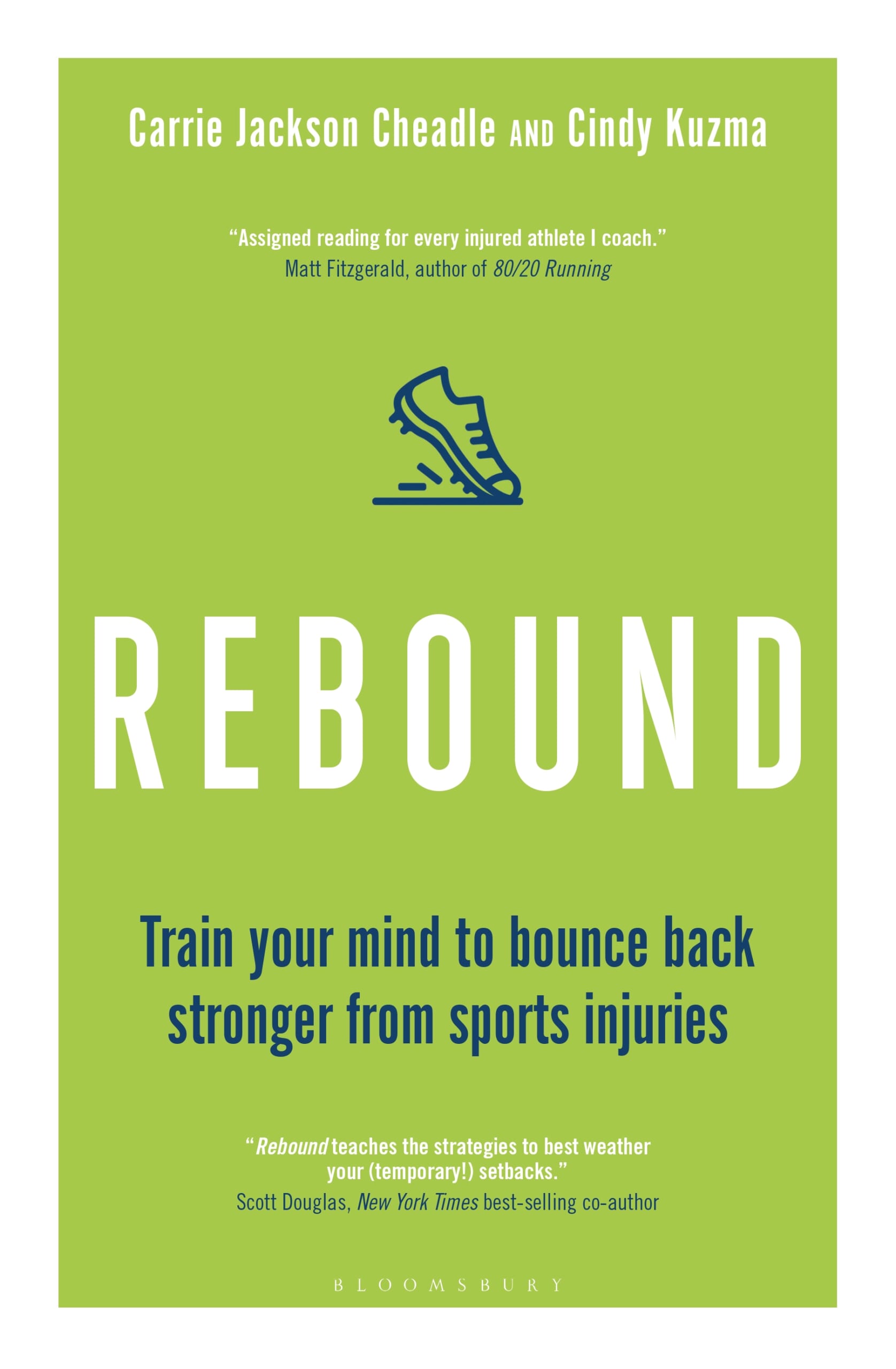5 Ways To Train Your Mind To Bounce Back Stronger From Sports Injuries
Required reading for anyone who needs to recover from a sports or workout injury.

Injuries suck—and no athlete, or person, wants to experience them. Yet they’re a nearly universal part of the athletic experience.
Even the best athletes in the world—from Olympic and Paralympic medalists to world champions to professional superstars—get hurt.

The best among them aren’t impervious to injury, but they do approach rehab and recovery differently.
We talked to more than 40 athletes for our new book, Rebound: Train Your Mind to Bounce Back Stronger From Sports Injuries. Nearly all of them said that, in some way, they walked away from the experience a better, stronger person within their sport and outside of it.
Why are these athletes able to rise up when others are knocked down? They react differently at critical, difficult moments in their injury process, from the first symptom onward. Each challenging set of circumstances they face becomes an opportunity to rebound—to harness energy that might naturally move downward into doubt, fear, and depression and instead focus it on regaining control and taking action.

You, too, can come to see injury as an opportunity. Mental skills empower shifting your momentum from the downward plunge and impact of injury to the upward trajectory of your recovery. Once you’ve learned to rebound from your injuries, each bounce can take you higher not just in your sport, but beyond it.
Here are a few key strategies that can make a big difference.
1. Make Recovery Your Sport
Before you got hurt, maybe you had goals: Run your fastest marathon, win a state title, earn the coveted spot on an Olympic team. These ambitions keep you driven when you’re at the peak of your performance, and one of the most challenging aspects of injury is watching them slip away.
Though it’s often hard to wrap your head around when it first happens, you can tap into the very same drive during your recovery process by creating new goals and timelines. You may have followed a path you didn’t intend and your destination may not even be exactly the same, but ultimately, you are still on an athletic journey.
Remember: You are still an athlete, and recovery is now your sport. It’s an idea that seems simple—but has the power to restore the sense of purpose to your life. The first step is to let go of your old goals and create new ones. These might include:
● Goals for your physical rehabilitation
● Mental training goals
● Lifestyle goals such as sleeping more or changing your diet
● Increasing your knowledge of the game or sport
● New performance or competition goals that take into account the probable timeline for your recovery
2. Embrace Uncertainty
Humans’ logical brains prefer predictability, a series of events spelled out in black and white. Injuries are unexpected, with shades of gray surrounding their consequences.
Choosing a positive way to respond to contradictions, doubt and uncertainty stand as one of the greatest challenges of being hurt. But if you can learn to master it, the resulting shift in perspective can prove immensely powerful.
Ironically, the first step in this process might be acknowledging just how big of an impact your injury has had. From there, you can consider the idea that you can actually experience positive changes through adversity, also known as “stress-related growth.”
Are we suggesting that you go out and get injured to experience this stress-related growth? Definitely NOT. But, we are suggesting that there may be another way of looking at your injury, to perceive this obstacle as a springboard toward something greater.
When you start to make this mindset shift, it can allow you to let go of things that are not in your control and focus on the things you can influence or change. It shifts your mindset from trying to grasp for ground underneath you to seeing what ground is still there and building on it.
3. Cultivate Curiosity
When you can tap into an authentic yearning to explore and understand, you’ll start to feel an emotional shift from being a victim of injury to wanting to learn about it. Instead of recoiling in fear or anger, you lean in, hoping to engage in and derive the most benefit from each step of the process. Essentially, you can transform into a student of your injury—and, indeed, of the entire experience.
Curiosity creates a sense of separation, so you can view your injury objectively versus being consumed by it. You shift from “Why is this happening to me?” to “What exactly is happening here?” Though it seems counterintuitive at first, this detachment actually makes it easier to take positive steps toward recovery.
4. Stay Present
Our thoughts have a natural tendency to time travel—moving into the past or into the future. Trouble is, your recovery is happening right here, in the present. Rewinding the tape to go back in time before you were injured or fast-forwarding it to the time when your injury is just a memory can keep you from recognizing where you are in this moment and staying focused on what you need to do right now.
One of the most powerful mental skills you can have as an athlete, and as a human, is the ability to stay in the present moment—or more specifically, the ability to bring yourself back to the present moment, and to do so without judgment.
Try this three-step process to drop the negative storylines spinning through your head, and trade the cycle of hopelessness, despair, and anxiety for positive forward momentum.
● Accept: Let go of what you can’t control.
● Adapt: Change your reactions to what’s happening.
● Act: Do what you can right now to create the best possible future.
These three steps don’t always proceed in exactly that order, or only unfold once. Recovery is rarely a linear process. However, that actually makes this framework even more reassuring. You can return to it anytime you start to feel yourself losing your perspective or focus.
5. Feed the Athlete
Thoughts have tremendous power to steer recovery in a positive direction—or to derail it completely. We all have a little athlete on one shoulder and a monster on the other; each thrives on a diet of our thoughts and beliefs.
Every day, you make choices about which one to nourish. When you’re injured, fear, doubt, and negativity can act like Miracle-Gro for your monster, naturally strengthening it. Fortunately, you can regain control of this equation during the injury and recovery process.
Feed the athlete with:
● Body language. The next time you feel hesitant or anxious, notice your body language in that moment; then take a breath and see if you can shift to reflect a position of greater confidence. Often, this physical repositioning jump-starts the shift in your mind.
● Thoughts. If you are about to do a rehabilitation exercise for the first time and find yourself feeling apprehensive, simply pause to recognize that emotion. If you can, verbalize it: “I’m feeling anxious.” You may immediately feel calmer, relieved. You can also shift your focus with cue words. These can be motivational (for instance, “calm” or “confident”) or instructional (“knees soft” or “chest up”).
● Imagery. Visually feed the athlete by seeing in your mind what you want to come true in your life. Depending on where you are in the rehab and recovery process, you might choose to focus on a different element. Healing imagery involves imaging your body recovering—bones strengthening, torn ligaments repairing—or a symbolic depiction, such as light or warmth in the injured area. With performance visualization, you picture yourself successfully performing a specific task—say, a rehab exercise—or imagining yourself in competition.
If you’re privileged enough to call yourself an athlete for long enough, you will probably face injury. Injuries cause a roller coaster of emotions, many negative. But you won’t always feel this way—and many athletes have overcome serious, life-altering injuries to make remarkable recoveries.
Mental skills give you incredible power to overcome obstacles and bounce back stronger—to rebound. You will get through this, and you might even realize, eventually, that you’re better for it.

